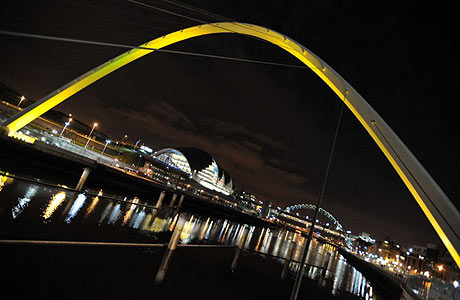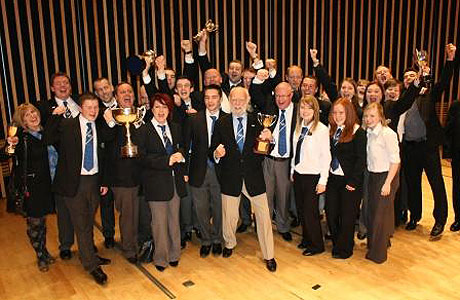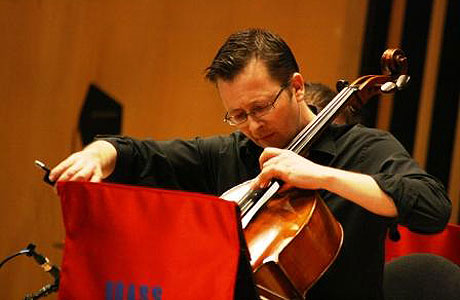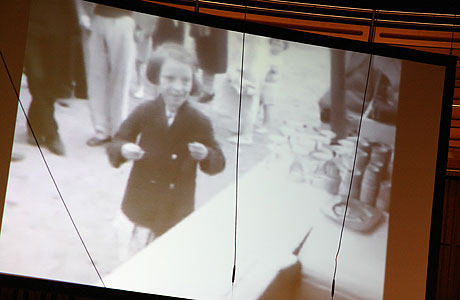
Change is in the air at Brass in Concert
Launched in 1977 to commemorate the Queen’s Silver Jubilee, the Rothmans Brass in Concert Championships may not have been the first band contest in the world with a focus on ‘entertainment’, but 35 years later, it has certainly become the leading event of its type in the banding world.
From the Rothmans factory in Darlington to the The Sage Gateshead, via the Dolphin and Spennymoor Leisure Centres, Brass in Concert’s move to The Sage in 2005 signalled a new era for the event.
Full of activity
It has now become a weekend full of activity.
It may only be 35 miles away from its geographical roots, but it has clearly undergone a lengthy journey from the vision of founders, Cyril Beere, Peter Hartley and David Bennett, who devised the original format in collaboration with long-time Music Advisor, Roy Newsome.
However, the contest rules and format have changed very little over the years, and after the 2011 event it was felt by the organising team of Paul and Jackie Beere, David Bennett, Trevor Caffull, John Woods and Alan Hope, that it may be time for a reappraisal of the situation.

Old system winners: Leyland celebrate their 2011 success
As John Woods explained: "It is important that Brass in Concert continues to evolve in the right way, keeping up with the constantly changing brass band landscape. With the passing of Roy, we found ourselves facing a decision over its future artistic direction and it was decided to form an advisory group rather than replacing Roy directly with a single voice.
We were indebted to Malcolm Brownbill for managing the judges at the 2011 contest, and following a subsequent workshop consultation with the bands that have competed in the past three years, we took their thoughts to the newly-formed group in January 2012.”
Expertise
He continued: “The advisory group was assembled with the aim of combining expertise to address some of the concerns representatives had about the contest’s format, as well as enhancing the many aspects of Brass in Concert that were considered to work well.
Chief among the bands’ concerns was the method of judging itself, which many considered no longer suitable, as well as making it difficult for them to know what would ‘work’ with different panels of adjudicators on any given day.
Those we approached to help us come up with solutions included Malcolm Brownbill, Kenneth Crookston, Alan Morrison, Simone Rebello, Frank Renton and, representing the views of a typical audience member, Stuart Bulmer.
After in-depth discussions, the organising team had a much clearer idea of how we wanted to proceed and produced a mission statement to help bands and adjudicators alike gain a greater understanding of each other’s role in the contest, as well as a corresponding scoring system."
Mission statement
In the end a Brass in Concert mission statement has been developed as follows:
‘The Brass in Concert Championship strives to provide a platform for the finest brass bands in the world to display, free of artistic restriction, their excellence as performers of high-quality original and arranged brass band music, through programmes and presentation reflecting the most current and progressive form of the genre and designed to appeal to both the general listener and aficionados of the discipline.’

A better scoring system for all...
Additions and amendments
It was also agreed that there was the need for an additional category of adjudication, augmenting the current ‘Music - Quality of Performance’ and ‘Entertainment and Presentation’ judges with a ‘Programme Content’ adjudicator - although the total number of adjudicators employed remains the same.
The scoring system has also been amended to add greater transparency to the process, as well as ensure that, from a mathematical point of view, the weightings allocated to each category have a corresponding effect on the overall outcome - not always the case using the old systems.
Clear roles
From 2012, judges will perform only in the roles for which they are engaged.
In other words, the Entertainment and Presentation judge should disregard Quality of Performance in his/her judgement and vice versa.
Weightings
Considerable discussion was also given to the relative weightings to be applied to each category.
The following format was agreed, with the table below demonstrating the points allocated to each band after the individual judges have placed them in order of merit.
QUALITY OF PERFORMANCE - 60 percent of the total
PROGRAMME CONTENT - 20 percent of the total
ENTERTAINMENT AND PRESENTATION - 20 percent of the total
| Position | Quality of Performance - A | Quality of Performance - B | Programme Content | Entertainment & Presentation | Max Total |
| 1 | 60 | 60 | 40 | 40 | 200 |
| 2 | 57 | 57 | 38 | 38 | 190 |
| 3 | 54 | 54 | 36 | 36 | 180 |
| 4 | 51 | 51 | 34 | 34 | 170 |
| 5 | 48 | 48 | 32 | 32 | 160 |
| 6 | 45 | 45 | 30 | 30 | 150 |
| 7 | 42 | 42 | 28 | 28 | 140 |
| 8 | 39 | 39 | 26 | 26 | 130 |
| 9 | 36 | 36 | 24 | 24 | 120 |
| 10 | 33 | 33 | 22 | 22 | 110 |
| 11 | 30 | 30 | 20 | 20 | 100 |
In playing their role in the new system, the two adjudicators for Quality of Performance will, without discussion, individually place each band in order of merit (as will the other judges), which will then be assigned a mark out of 60 points by the Contest Controller in accordance with the new scoring system.
Their combined marks will represent 60 percent of the total marks (and overall points differential) awarded for the contest.
Quality counts
In the event of a tie for any overall positions, the band with the highest combined points score for Quality of Performance shall take precedence.
If it remains tied at this stage, then the score of one of the Quality of Performance judges, who shall be assigned the role of 'Judge A' prior to the contest, shall take priority.
Innovation
The adjudicator for Programme Content will take into account aspects including programme concept, quality of compositions and arrangements, programme balance, musical invention, innovation and the level of input that has been made to deliver the band’s overall presentation.

Freedom of artistic impression will be encouraged
In order to fulfil the role, this judge should have a good knowledge of the programmes that have been presented at Brass in Concert by the competing bands in the recent past, but should also remain open-minded and pay particular attention to the principle of freedom from artistic restriction that appears in the mission statement.
No prescription
Although it is considered unnecessary for the organisers to offer a ‘prescription’ to be followed while performing this role, the adjudicator will be instructed to reward the programmes containing high-quality original and arranged brass band music wherever possible.
The single adjudicator for Entertainment and Presentation will take into account audience reaction, input and engagement, presentation/entertainment and impact and use of facilities and resources such as the multimedia screen.
He/she will not be concerned with the quality of playing except as it affects his/her enjoyment of the programme.
The role of the Solo adjudicator will be largely unchanged.
Process
John Woods added: “With considerable change in the adjudication roles, it is, of course, absolutely imperative that we employ adjudicators of the highest calibre.
We are currently in the process of appointing the judges for 2012 and hope to be able to make an announcement in the next few weeks. Above all, we hope that the new format will bring greater clarity and understanding to the event, for the competing bands, the judges and our loyal audience.”
Plans
It isn’t only the judges’ input and the format that have been amended, as the competing bands are also being requested to bring their plans for the event forward, to hopefully enhance the overall experience for those attending the event.

Screen shots must be monitored
Cut back in numbers
John explained: “As the competitors are among the finest in the world, we no longer consider it necessary to allow them to borrow up to five players. Bands will now be able to use two guests from bands not competing at the event.
We will also be requesting that their music programmes are available 21 days before the contest, to allow us to print them in the souvenir programme for the Festival."
Best experience
He concluded "It is also important that anyone wishing to use the excellent lighting and display facilities at The Sage gives plenty of notice, while also making sure that any copyright material is being used legally. We have tightened up the entry conditions a bit to make sure that these aspects of the event are all in order.
Above all, we want to provide the best possible experience for the paying public and for the competitors, and we are confident that the changes we have made for the 2012 event will do this.”
A full version of this article appeared in British Bandsman magazine issue 5716 on 5th May
For further information go to:www.britishbandsman.com/













